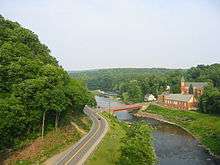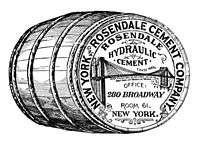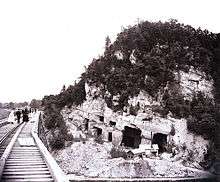Rosendale, New York
| Rosendale, New York | |
|---|---|
| Town | |
_highlighted.svg.png) Location in Ulster County and the state of New York. | |
| Coordinates: 41°50′49″N 74°4′34″W / 41.84694°N 74.07611°W | |
| Country | United States |
| State | New York |
| County | Ulster |
| Area | |
| • Total | 20.7 sq mi (53.7 km2) |
| • Land | 19.9 sq mi (51.6 km2) |
| • Water | 0.8 sq mi (2.1 km2) |
| Elevation | 56 ft (17 m) |
| Population (2010) | |
| • Total | 6,075 |
| Time zone | Eastern (EST) (UTC-5) |
| • Summer (DST) | EDT (UTC-4) |
| ZIP code | 12472 |
| Area code(s) | 845 Exchange: 658 |
| FIPS code | 36-63737 |
| GNIS feature ID | 0979435 |
Rosendale is a town in the center of Ulster County, New York, United States. It once contained a village of the same name, which was dissolved through a vote. The population was 6,075 at the 2010 census.
History

The region was first settled by Europeans around 1685. The Town of Rosendale was formed in 1844 from parts of the Towns of Hurley, Marbletown, and New Paltz.




The following is a description of the town circa 1870:
ROSENDALE was formed from Marbletown, New Paltz and Hurley, April 26, 1844. It is an interior town, lying east of the center of the County. The surface is a rolling and broken upland, the highest summits being from 200 to 500 feet above the valleys. Rondout Creek flows north-east through the town near the center, receiving Coxingkill from the south, and Cottlekill from the north. The Delaware and Hudson Canal extends along the Rondout Creek. The soil is chiefly a sandy loam. In the north-west part of the town are several small lakes, called the Binnewaters. Cement is extensively manufactured throughout the town. The Wallkill Valley R.R. extends through the whole length of the town. In the south-west part are three caves, in a ledge of rocks of the Shawangunk Mountains, where ice is found at all times of the year.Rosendale. (p.v.) situated on the creek and canal, near the center of the town, contains three churches, viz., Reformed, Baptist and Roman Catholic; two hotels, two stores, a school, two blacksmith shops, three wagon shoes, an undertaker, coal yard, a harness shop, a shoe shop, two milliners, a meat market, a cement kiln and about 550 inhabitants. The W.V. R.R. crosses the creek at this place on a bridge 900 feet long and 140 feet above the water.
Lawrenceville, names in honor of Mr. Watson E. Lawrence, is situated on the creek, about a mile above Rosendale, and contains two cement manufactories and about 400 inhabitants.
The Rosendale Cement Company's Mills at this place, have a capacity for manufacturing about 350 barrels daily, and give employment to about 60 men. This is the pioneer company in the manufacture of cement, and was established by Mr. Watson E. Lawrence, who now resides in New York.
Lawrenceville Cement Co. have a capacity for manufacturing about 125,000 barrels each season, giving employment to about 130 men. The mills are on the Delaware and Hudson Canal.
Bruceville, in the west part of the town, on Rondout Creek, about two and a half miles from Rosendale, contains a store, a cement mill and fifteen dwellings.
The Bruceville Cement Manufactory makes about 30,000 barrels each season, and gives employment to about 35 hands. The mills have a capacity for about 300 barrels per day. James H. Van Demark is the proprietor.
A mineral spring at this place receives some patronage.
Rosendale Plains is a hamlet about one and a fourth miles south of Rosendale, and contains a hotel, a blacksmith shop, a trotting course and ten dwellings.
LeFevre Falls, (p.v.) formerly known as Rook Lock, is situated about a mile below Rosendale, and contains a store, three hotels, two cement manufactories and about thirty dwellings.
The New York Cement Company, at this place, manufacture about 500 barrels of cement per day and about 100,000 barrels during the season.
Martin & Clearwater's Cement Works have a capacity for making 80,000 barrels per season, and give employment to about one hundred men.
Whiteport, in the north-east part of the town, is about four miles north from Rosendale, and about the same distance south-west of Rondout. It contains the Neward & Rosendale Lime and Cement Works and a population of about 1,500, including what is known as Hickory Bush. The village has been built up almost wholly by the Cement Works. They manufacture about 800 barrels per day, and have a capacity for 1,000 barrels. The barrels are all made here and their cement is transported to tide water over a horse railroad. They employ about 180 men. The quarries are entered by tunnels, two of which are 200 feet in length each, and one seventy feet. They have a perpendicular depth of about 120 to 140 feet. They have seventeen kilns, fifteen of which are in constant use. It is ground in a mill containing twelve runs of three feet stones, the power being a fifty horse-power water wheel and two 100 horse-power engines.
The Lawrence Cement Company was established in 1848. Their works are about a mile south of Whiteport. They manufacture about 550 barrels per day, and give employment to about 100 men. Their cement is quarried and burned here, and transported over a horse railroad to Eddyville, where it is ground and shipped.
Creek Locks, (p.v) in the east part of the town, where the canal locks into the creek, contains two stores, a grocery, a school and about 25 dwellings. The Hudson River Cement Works, located on the Hudson River, a few miles above Rondout, have an extensive quarry near Creek Locks, where they give employment to about fifty men. The stone is conveyed from the quarry about three-eights of a mile on an inclined plain railway, the descending cars drawing up the ascending ones. The Warner Lime and Cement Co. of Troy, have a quarry and kilns in this town, where they give employment to fifteen men.
The first settlement of this town was made about 1700. It received its name from the old “Rosendale Farm” where an inn was kept in 1711. The place is now owned by Mrs. M.C. Cornell. It was the residence of Col. Rutzer, one of the patentees. The house is of stone and was for a long time the office of the Loan Commissioner of the County. General Washington visited the County in June 1783, when Mrs. Washington and Governor and Mrs. Clinton were entertained in this house by Col. Hardenburgh. As this town had no separate organization until 1844, its early history is blended with that of adjacent towns from which it was taken.
“Gordon's Gazetteer” published in 1836, says the village of Rosendale contains ten or twelve dwellings and a hydraulic cement factory, owned by W.E. Lawrence, and giving employment to from 100 to 200 hands, and producing 500 casks daily.
The Reformed Church was the first organized in the town. Rev. J. McFarland was the first pastor. Their house of worship was erected in 1843; it will seat 300 and cost $2,500. The present membership is 82. Rev. M.F. Libeneau is the pastor.
The New School Baptist Church was organized by Lewis Raymond with 26 members. The first pastor was David Mores. Their house of worship was erected in 1841; it will seat 350 and cost $1,600. Its present value is $3,500. The present membership is 70, and the pastor is Rev. D. Van Fredenburgh.
The population in 1870 was 3,625, and its area 11,299 acres, with an assessed value of $442,920.
There are seven school districts, employing nine teachers. The number of children of school age is 1,256; the number attending school, 775; the average attendance, 347, and the value of school houses and sites, $7,850.[1]
— Hamilton Child, Gazetteer and Business Directory Of Ulster County, N. Y. For 1872-2
St. Peter's Roman Catholic Church
In the mid 1800s priests from St. Peter's in Poughkeepsie served missions in Saugerties and Rondout. In 1840 Rev. John N. Smith, pastor in Poughkeepsie, extended his care to Rosendale. In 1842, his successor, Rev. Myles Maxwell celebrated Mass in Petrie's cooper shop. That same year Maxwell was named the first resident pastor of St. Mary's in Rondout, and Rosendale became a mission served out of Rondout.[2]
St. Peter's Roman Catholic Church was organized by Father Thomas Martin O.P., pastor of St. Mary's in Rondout. Services were held in the home of Walter Delmar. In August 1850 the first Mass was celebrated in the new church. St. Peter's remained a mission of St. Mary's until 1855 when Rev. Edward Lynch, assistant at St. Mary's, was named pastor of the new parish of St. Peter's, Rosendale. In 1874 Rev. Martin O'Flaherty became pastor. Given the ever-increasing Catholic population, attracted by the opportunity of employment in the cement quarries, plus the Delaware & Hudson Canal, a new, larger church building, designed by Arthur Crooks, was built. The first Mass in the new church was celebrated on Christmas Day 1876. [2]
In 1881 pastor John J. Gleason built a parish school and convent. The school was staffed by the Sister of Charity. Upon Gleason's death in 1894, he left a bequest of $500 to Kingston hospital. A mission was established in Whiteport. In 1897, Rev. P. Maughan, a Civil War veteran, became pastor and built the parish hall.[2]
Rosendale cement

The Rosendale region is most well known for the production of natural cement. The Rosendale natural cement industry began during of the construction the Delaware and Hudson Canal in 1825. Rosendale natural cement soon gained a reputation for quality among engineers and was used in the construction of many of the United States' most important landmarks, including the Brooklyn Bridge, the pedestal of the Statue of Liberty, Federal Hall National Memorial, and one of the wings of the United States Capitol. The industry fell into decline in the early 1900s.[3]
Rosendale natural cement was produced from dolostone extracted from the Rosendale and Whiteport members of the Late Silurian Rondout Formation. The natural levels of magnesium and clay in the dolostone from the Rondout Formation are ideally suited for cement production and required none of the chemical additives characteristic of modern Portland cement production.
Several abandoned dolostone mines still exist in the Rosendale region. A mine on the property of the Snyder Estate, which is maintained as part of a museum preserving the history of the Rosendale natural cement industry by the Century House Historical Society, is open to the public. Other mines have been put to a number of uses, including mushroom farming and movie locations. The records storage management company Iron Mountain currently maintains at least one mine for storing anything from microfiche to data backup tapes.
In 2004 limited cement mining resumed in Rosendale, and Rosendale natural cement is again being produced. Freedom Cement LLC, in North Brookfield, Massachusetts, is producing natural cement for use in historic restoration projects.
Geography

According to the United States Census Bureau, the town has a total area of 20.8 square miles (54 km2), of which, 19.9 square miles (52 km2) of it is land and 0.8 square miles (2.1 km2) of it (3.90%) is water.
Rosendale is bisected or bordered by natural and man-made formations. The New York State Thruway (Interstate 87) passes through the town, and the Rondout Creek joins the Wallkill River by the east town line.
Demographics
| Historical population | |||
|---|---|---|---|
| Census | Pop. | %± | |
| 1850 | 2,418 | — | |
| 1860 | 2,826 | 16.9% | |
| 1870 | 3,625 | 28.3% | |
| 1880 | 4,724 | 30.3% | |
| 1890 | 6,063 | 28.3% | |
| 1900 | 6,278 | 3.5% | |
| 1910 | 3,717 | −40.8% | |
| 1920 | 1,959 | −47.3% | |
| 1930 | 2,192 | 11.9% | |
| 1940 | 2,548 | 16.2% | |
| 1950 | 2,950 | 15.8% | |
| 1960 | 4,228 | 43.3% | |
| 1970 | 5,422 | 28.2% | |
| 1980 | 5,933 | 9.4% | |
| 1990 | 6,220 | 4.8% | |
| 2000 | 6,352 | 2.1% | |
| 2010 | 6,075 | −4.4% | |
| Est. 2014 | 5,980 | [4] | −1.6% |
As of the census[6] of 2000, there were 6,352 people, 2,587 households, and 1,634 families residing in the town. The population density was 318.5 people per square mile (123.0/km²). There were 2,857 housing units at an average density of 143.3 per square mile (55.3/km²). The racial makeup of the town was 95.72% White, 1.79% African American, 0.28% Native American, 0.44% Asian, 0.43% from other races, and 1.34% from two or more races. Hispanic or Latino of any race were 2.63% of the population.
There were 2,587 households out of which 30.4% had children under the age of 18 living with them, 48.3% were married couples living together, 10.1% had a female householder with no husband present, and 36.8% were non-families. 28.2% of all households were made up of individuals and 8.4% had someone living alone who was 65 years of age or older. The average household size was 2.45 and the average family size was 3.02.
In the town the population was spread out with 24.6% under the age of 18, 6.8% from 18 to 24, 31.9% from 25 to 44, 25.3% from 45 to 64, and 11.3% who were 65 years of age or older. The median age was 38 years. For every 100 females there were 97.3 males. For every 100 females age 18 and over, there were 93.5 males.
The median income for a household in the town was $44,282, and the median income for a family was $51,444. Males had a median income of $34,321 versus $28,787 for females. The per capita income for the town was $21,303. About 8.4% of families and 11.9% of the population were below the poverty line, including 17.5% of those under age 18 and 9.6% of those age 65 or over.
Communities and locations in Rosendale
Communities
- Binnewater – A hamlet north of Rosendale village.
- Bloomington – A hamlet in the northeast part of the town, southeast of Whiteport.
- Bruceville – A hamlet in the southwest part of the town, southwest of Rosendale village.
- Cottekill – A hamlet northwest of Rosendale village.
- Creeklocks – A hamlet at the east town line, south of Bloomington and on the west bank of Rondout Creek.
- Hickory Bush – A hamlet in the northeast part of the town, south of Whiteport and located on the west bank of Rondout Creek.
- High Falls – A hamlet and census-designated place at the town line by the southwest part of the town.
- Kallops Corners – A hamlet north of Rosendale village
- Lawrenceville – A hamlet west of Rosendale village on Route 213.
- Lefevere Falls – A hamlet adjacent to the Thruway and northeast of Rosendale village.
- Maple Hill – A hamlet north of Lefever Falls and Rosendale village.
- Rosendale (also known as Rosendale Village or Rosendale Hamlet) – A hamlet and census-designated place in the eastern half of the town by Rondout Creek. It was a village until 1977.
- Tillson – A hamlet and census-designated place south of Rosendale village
- Whiteport – A hamlet in the northeast corner of the town adjacent to the Thruway.
Locations
- Sturgeon Pool – A wide part of the Wallkill River at the east town line.
References
- ↑ History of Rosendale, NY, FROM: Gazetteer and Business Directory Of Ulster County, N. Y. For 1872-2. Compiled and Published By Hamilton Child, Syracuse, NY 1871
- 1 2 3 Burtsell, Richard Lalor. "The Roman Catholic Church", Clearwater, Alphonso Trumpbour. The History of Ulster County, New York, W. J. Van Deusen, 1907 - Ulster County (N.Y.)
- ↑ "Natural Cement Comes Back", October 1941, Popular Science
- ↑ "Annual Estimates of the Resident Population for Incorporated Places: April 1, 2010 to July 1, 2014". Retrieved June 4, 2015.
- ↑ "Census of Population and Housing". Census.gov. Retrieved June 4, 2015.
- ↑ "American FactFinder". United States Census Bureau. Retrieved 2008-01-31.
External links
Coordinates: 41°50′38″N 74°04′56″W / 41.84389°N 74.08222°W
